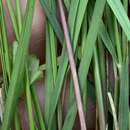Comprehensive Description
provided by North American Flora
Danthonia sericea Nutt. Gen. 1: 71. 1818
Danthonia glabra Nash, Bull. Torrey Club 24: 43. 1897. (Type from Little Stone Mountain,
Georgia, Small in 1895.) Not D. glabra Philippi, 1896. Danthonia epilis Scribn. Circ. U. S. Dep. Agr. Agrost. 30: 7. 1901. (Based on D. glabra Nash.) Merathrepta sericea A. Heller. Muhlenbergia 5: 120. 1909. (Based on Danthonia sericea Nutt.) Pentameris epilis Nelson & Macbr. Bot. Gaz. 56: 469. 1913. (Based on Danthonia epilis Scribn.) Pentameris sericea Nelson & Macbr. Bot. Gaz. 56: 470. 1913. (Based on Danthonia sericea Nutt.)
Culms erect, densely tufted, 50-100 cm. tall; sheaths, especially the lower, villous (rarely glabrous); blades 10-25 cm. long, 2-4 mm. wide, those of the innovations mostly involute, those of the culm mostly flat, sparsely villous to glabrous; panicle 5-10 cm. long, relatively many-flowered, the branches bearing 2-6 spikelets, rather open, or contracted after anthesis; glumes 12-17 mm. long; lemmas densely long-pilose, especially along the margin, about 10 mm. long, including the slender aristate teeth, the teeth about half the entire length; terminal segment of the dorsal awn 8-10 mm. long; palea narrowed toward the 2-toothed apex.
TvpB locality: "Carolina to Florida;" the type from Georgia.
Distribution: Sandy soil and sterile woods, chiefly on the coastal plain, Massachusetts and New Jersey to northern Florida, Tennessee, and Louisiana.
- bibliographic citation
- Albert Spear Hitchcock, Jason Richard Swallen, Agnes Chase. 1939. (POALES); POACEAE (pars). North American flora. vol 17(8). New York Botanical Garden, New York, NY
Physical Description
provided by USDA PLANTS text
Perennials, Terrestrial, not aquatic, Rhizomes present, Stems nodes swollen or brittle, Stems erect or ascending, Stems caespitose, tufted, or clustered, Stems terete, round in cross section, or polygonal, Stem internodes hollow, Stems with inflorescence less than 1 m tall, Stems with inflorescence 1-2 m tall, Stems, culms, or scapes exceeding basal leaves, Leaves mostly basal, below middle of stem, Leaves conspicuously 2-ranked, distichous, Leaves sheathing at base, Leaf sheath mostly open, or loose, Leaf sheath smooth, glabrous, Leaf she ath or blade keeled, Leaf sheath and blade differentiated, Leaf blades linear, Leaf blades very narrow or filiform, less than 2 mm wide, Leaf blades 2-10 mm wide, Leaf blades mostly flat, Leaf blade margins folded, involute, or conduplicate, Leaf blades mostly glabrous, Leaf blades scabrous, roughened, or wrinkled, Ligule present, Ligule a fringe of hairs, Inflorescence terminal, Inflorescence an open panicle, openly paniculate, branches spreading, Inflorescence a contracted panicle, narrowly paniculate, branches appressed or ascending, Inflorescence solitary, with 1 spike, fascicle, glomerule, head, or cluster per stem or culm, Flowers bisexual, Spikelets pedicellate, Spikelets laterally compressed, Spikelet 3-10 mm wide, Spikelets with 3-7 florets, Spikelets with 8-40 florets, Spikelets solitary at rachis nodes, Spikelets all alike and fertille, Spikelets bisexual, Inflorescence disarticulating between nodes or joints of rachis, rachis fragmenting, Spikelets disarticulati ng above the glumes, glumes persistent, Spikelets disarticulating beneath or between the florets, Rachilla or pedicel glabrous, Glumes present, empty bracts, Glumes 2 clearly present, Glumes equal or subequal, Glumes equal to or longer than adjacent lemma, Glumes 4-7 nerved, Lemma coriaceous, firmer or thicker in texture than the glumes, Lemma 5-7 nerved, Lemma 8-15 nerved, Lemma glabrous, Lemma apex dentate, 2-fid, Lemma distinctly awned, more than 2-3 mm, Lemma with 3 awns, Lemma awn 1-2 cm long, Lemma awned from tip, Lemma awn from sinus of bifid apex, Lemma awn twisted, spirally coiled at base, like a corkscrew, Lemma awn once geniculate, bent once, Lemma margins thin, lying flat, Lemma straight, Palea present, well developed, Palea about equal to lemma, Palea 2 nerved or 2 keeled, Stamens 3, Styles 2-fid, deeply 2-branched, Stigmas 2, Fruit - caryopsis, Caryopsis ellipsoid, longitudinally grooved, hilum long-linear.

